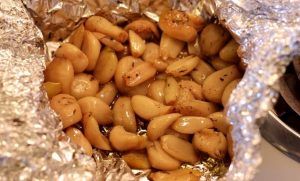This delightful Portuguese seafood stew combines the freshest seafood with hearty chorizo and aromatic seasonings. The simplicity of this dish pays homage to Portuguese coastal cuisine, promising a comforting and flavorful meal that's perfect for any occasion.
Two ingredients you might not have on hand are neck clams and chorizo sausage. Neck clams, also known as littleneck clams, are small, sweet, and tender, making them a great addition to this stew. Chorizo is a type of pork sausage, popular in Spanish and Mexican cuisines, known for its rich, smoky flavor. You can find both in most supermarkets or specialty food stores. If you can’t find neck clams, you can substitute with any small clam. Likewise, if you can’t find chorizo, andouille sausage makes an appropriate substitute.
Ingredients for the Portuguese Seafood Stew
Neck clams: A type of small clam, known for their sweet and tender meat. They add a distinct ocean flavor to the stew.
Shrimp: Adds a delicate and slightly sweet flavor to the stew.
Scallops: These will provide a tender, buttery flavor.
Olive oil: Used to sauté the garlic and onion, and provides a rich, fruity base for the stew.
Garlic: Adds a robust flavor, enhancing the overall taste of the stew.
Onion: Provides a sweet and tangy flavor that balances the seafood.
Chorizo sausage: A spicy pork sausage that infuses the stew with a smoky, rich flavor.
Tomato: Adds a slight tangy taste, balancing out the richness of the other ingredients.
Dry white wine: Used to deglaze the pot, and adds a sophisticated, fruity note to the stew.
Bay leaf: This aromatic leaf adds a subtle, herbal flavor.
Fresh parsley: Used for garnish and adds a fresh, earthy taste.
Salt: Enhances the flavors of the other ingredients.
Fresh pepper: Adds a bit of heat, balancing the sweetness of the seafood.
One reader, Brnaby Hales says:





This Portuguese seafood stew recipe is a game-changer! The flavors are rich and the seafood is perfectly cooked. The combination of clams, shrimp, and scallops in a savory broth is simply divine. It's a must-try for any seafood lover!
Techniques Required for Portuguese Seafood Stew
How to sauté garlic and onion: In a large heavy pot, heat olive oil over medium flame. Add minced garlic and finely chopped onion, and sauté for about 2 minutes until they are fragrant and translucent.
How to cook clams: After adding the clams to the pot, cover and cook for about 5 minutes, or until all the clams open. Discard any clams that remain closed as they may be unfit for consumption.
How to cook shrimp and scallops: After the clams have opened, add the shrimp and scallops to the pot and cook for an additional 2 to 3 minutes, or until the seafood is completely cooked through. Be careful not to overcook the seafood to maintain its tenderness and flavor.
How To Make Portuguese Seafood Stew
Make a comforting bowl of Portuguese seafood stew for dinner with this recipe. Cook clams, shrimp, tomatoes, and scallops in white wine for a tasty meal.
Serves:
Ingredients
- 36neck clams,little, scrubbed and clean
- 1lbshrimp,large, peeled and deveined
- 1lbscallops
- 1tbspolive oil,extra-virgin
- 4cloves garlic,minced
- ½onion,chopped
- 1 ¾ozchorizo sausage,sliced
- 1tomato,diced
- ¾cupdry white wine,like Pinot Grigio
- ¼cupwater
- 1bay leaf
- ½cupfresh parsley,finely chopped
- salt and fresh pepper,to taste
Instructions
-
In a large heavy pot, saute garlic and onion in olive oil over medium flame for about 2 minutes.
-
Add chorizo, tomatoes, wine, bay leaf, ¼ cup parsley, salt, and pepper. Simmer for 5 minutes.
-
Add the clams, mix well, and cover.
-
Cook for about 5 minutes, or until all the clams open. Discard any closed clams.
-
Add shrimp and scallops and cook for an additional 2 to 3 minutes, until seafood is completely cooked.
-
Ladle into bowls and top with a little fresh parsley.
-
Serve and enjoy!
Nutrition
- Calories: 489.20kcal
- Fat: 17.39g
- Saturated Fat: 5.28g
- Trans Fat: 0.05g
- Monounsaturated Fat: 8.14g
- Polyunsaturated Fat: 2.13g
- Carbohydrates: 16.17g
- Fiber: 1.37g
- Sugar: 2.00g
- Protein: 56.14g
- Cholesterol: 234.19mg
- Sodium: 2230.85mg
- Calcium: 156.06mg
- Potassium: 735.01mg
- Iron: 4.22mg
- Vitamin A: 225.18µg
- Vitamin C: 16.35mg
Technique Tip for Portuguese Seafood Stew Recipe
When cooking clams, it's important to remember that they will open when they are fully cooked. If after cooking, some of your clams remain closed, it's best to discard them as they might not be safe to eat. Also, when adding the shrimp and scallops, be careful not to overcook them. Seafood cooks quickly and can become tough if left on the heat for too long. A good indication that your shrimp and scallops are done is when they become opaque.
Time-Saving Tips for Portuguese Seafood Stew Recipe
Plan ahead: Before starting the recipe, make sure to have all the ingredients and equipment ready to go. This will save time and make the cooking process smoother.
Prep in advance: Wash and chop vegetables, clean seafood, and measure out ingredients ahead of time to streamline the cooking process.
One-pot wonders: Look for recipes that can be prepared in a single pot or pan to minimize cleanup and save time on washing dishes.
Use kitchen tools: Utilize kitchen gadgets like food processors, mandolines, and garlic presses to speed up the prep work.
Follow the recipe: Stick to the recipe measurements and instructions to avoid mistakes that could lead to time-consuming fixes.
Substitute Ingredients For Portuguese Seafood Stew Recipe
neck clams - Substitute with mussels: Mussels have a similar briny flavor and texture to clams, making them a suitable substitute in the stew.
shrimp - Substitute with prawns: Prawns have a similar taste and texture to shrimp, making them a great alternative in the stew.
scallops - Substitute with monkfish: Monkfish has a firm texture and sweet flavor similar to scallops, making it a good substitute in the stew.
olive oil - Substitute with avocado oil: Avocado oil has a mild flavor and high smoke point, making it a suitable substitute for olive oil in the recipe.
garlic - Substitute with shallots: Shallots have a mild garlic flavor and can be a good substitute in the stew.
onion - Substitute with leeks: Leeks have a mild onion flavor and can be used as a substitute in the stew.
chorizo sausage - Substitute with linguiça sausage: Linguiça sausage has a similar smoky and spicy flavor to chorizo, making it a suitable substitute in the stew.
tomato - Substitute with red bell pepper: Red bell pepper can add a similar sweetness and color to the stew as tomatoes.
dry white wine - Substitute with chicken or vegetable broth: Broth can add depth of flavor to the stew, similar to white wine.
bay leaf - Substitute with thyme: Thyme can add a similar earthy and aromatic flavor to the stew as bay leaf.
fresh parsley - Substitute with cilantro: Cilantro can add a fresh and herbaceous flavor to the stew, similar to parsley.
Presenting Portuguese Seafood Stew
Elevate the seafood: Arrange the clams, shrimp, and scallops in an artful and visually appealing manner on the plate, ensuring each piece is showcased beautifully.
Garnish with fresh herbs: Sprinkle the dish with a generous amount of freshly chopped parsley to add a pop of color and a burst of fresh flavor.
Incorporate a touch of elegance: Consider serving the Portuguese seafood stew in a sophisticated ceramic bowl or a stylish copper pot to enhance the dining experience.
Add a splash of color: Introduce a vibrant element to the presentation by incorporating a slice of lemon or a sprinkle of paprika for a visually striking touch.
Emphasize the seafood: Highlight the star ingredients by arranging them in a way that showcases their natural beauty and appeal, allowing the seafood to take center stage.
Consider the vessel: Choose a serving vessel that complements the rustic charm of the dish, such as a traditional earthenware dish or a classic cast iron pot for a touch of authenticity.
Artful drizzle: Finish the presentation with a delicate drizzle of extra virgin olive oil to add a glossy sheen and a hint of richness to the dish.
Attention to detail: Pay close attention to the placement of each element, ensuring that the presentation reflects precision and care in every aspect.
Essential Tools for Making Portuguese Seafood Stew
- Large heavy pot: A large, sturdy pot is essential for cooking the stew, as it allows for even heat distribution and ample space for the ingredients.
- Saute pan: A saute pan is useful for sauteing the garlic and onion in the initial steps of the recipe.
- Chef's knife: A sharp chef's knife is necessary for chopping ingredients such as garlic, onion, and tomatoes.
- Cutting board: A cutting board provides a stable surface for chopping and preparing the ingredients.
- Ladle: A ladle is used for serving the stew into bowls.
- Tongs: Tongs are helpful for handling the seafood while cooking and serving.
- Wooden spoon: A wooden spoon is useful for stirring the stew and ensuring that the ingredients are well combined.
- Measuring cup: A measuring cup is essential for accurately portioning the white wine and water in the recipe.
- Kitchen knife: A kitchen knife is necessary for preparing the seafood, such as deveining the shrimp or removing the shells from the clams.
- Cooking spoon: A cooking spoon is used for stirring and mixing the ingredients in the pot.
- Soup bowls: Soup bowls are needed for serving the Portuguese seafood stew.
Storing and Freezing Portuguese Seafood Stew
Let the portuguese seafood stew cool completely before storing or freezing. This will prevent the formation of harmful bacteria and ensure that the stew maintains its quality and flavor.
Transfer the cooled stew to an airtight container or a heavy-duty freezer bag. If using a container, make sure to leave about an inch of headspace at the top to allow for expansion during freezing.
Label the container or bag with the date and contents, so you can easily keep track of when the stew was made and how long it has been stored.
If storing in the refrigerator, the portuguese seafood stew will keep for up to 3-4 days. Make sure to place the container in the coldest part of the fridge, typically the back.
When freezing, the stew can be kept frozen for up to 2-3 months. To prevent freezer burn, consider placing the freezer bag or container inside another bag or wrapping it in aluminum foil for an extra layer of protection.
To reheat the frozen stew, transfer it to the refrigerator and let it thaw overnight. Once thawed, reheat the stew in a pot on the stove over medium heat, stirring occasionally, until it is heated through and reaches a safe internal temperature of 165°F (74°C).
If you plan on freezing the stew, consider undercooking the seafood slightly during the initial cooking process. This will help prevent the shrimp, scallops, and other delicate seafood from becoming tough or rubbery when reheated.
Avoid freezing the stew multiple times, as this can negatively impact its texture and flavor. If you don't think you'll consume the entire batch within a few months, consider freezing the stew in smaller, portion-sized containers for more convenient thawing and reheating.
How To Reheat Leftovers of Portuguese Seafood Stew
Reheat the portuguese seafood stew in a large pot over medium-low heat, stirring occasionally, until it reaches a simmer. This gentle reheating method ensures that the delicate seafood remains tender and doesn't overcook. The slow heating process also allows the flavors to meld together, resulting in an even tastier stew.
If you're short on time, you can reheat individual portions of the stew in the microwave. Transfer the desired amount to a microwave-safe bowl, cover it with a damp paper towel, and heat it in 30-second intervals, stirring between each interval, until it's heated through. Be careful not to overheat the seafood, as it can quickly become rubbery.
For a crispy twist, reheat the stew in a large skillet or sauté pan over medium heat. This method works best if you have a smaller amount of leftover stew. As the stew heats up, the bottom will develop a slightly caramelized, crispy layer, adding a new dimension of texture and flavor to the dish.
If the stew has thickened up considerably in the refrigerator, you can thin it out with a splash of white wine, fish stock, or water while reheating. This will help restore the stew's original consistency and prevent it from becoming too dense or dry.
To enhance the flavor of the reheated stew, consider adding a squeeze of fresh lemon juice or a sprinkle of chopped parsley just before serving. These bright, fresh elements will help revive the flavors and make the stew taste as if it were freshly prepared.
Interesting Fact About Portuguese Seafood Stew
The Portuguese seafood stew, also known as Caldeirada de Marisco, is a traditional dish from Portugal. It is a flavorful and hearty stew that showcases the abundance of seafood found along the country's coastline. This dish is often enjoyed with crusty bread to soak up the delicious broth. It is a popular choice in Portuguese coastal regions and is often served at family gatherings and celebrations. The stew is a testament to the rich maritime heritage of Portugal and the culinary traditions that have been passed down through generations.
Is Portuguese Seafood Stew Recipe Budget-Friendly?
This Portuguese seafood stew recipe is moderately cost-effective for a household. The combination of clams, shrimp, and scallops may be on the pricier side, but the dish's rich flavors and nutritional value make it a worthwhile investment. The estimated cost for a household of four people is approximately $45. The versatility of seafood allows for various cooking methods, making it a valuable addition to any kitchen. Overall Verdict: 8/10
Is Portuguese Seafood Stew Healthy or Unhealthy?
The Portuguese seafood stew recipe is a relatively healthy dish, thanks to its abundance of nutrient-rich seafood and vegetables. Clams, shrimp, and scallops are excellent sources of lean protein, omega-3 fatty acids, and essential minerals like iron and zinc. The inclusion of garlic, onion, and tomato provides additional vitamins and antioxidants. However, the recipe does contain some elements that could be modified to make it even healthier.
The chorizo sausage, while adding flavor, is high in saturated fat and sodium. To improve the recipe's healthiness, consider:
- Reducing the amount of chorizo or replacing it with a leaner protein like chicken or turkey sausage
- Using low-sodium broth instead of water to enhance flavor without adding extra salt
- Increasing the variety and quantity of vegetables, such as bell peppers, zucchini, or kale, to boost the dish's fiber and nutrient content
- Opting for whole grain bread or a side salad instead of white bread to accompany the stew
By making these simple adjustments, you can elevate the Portuguese seafood stew's nutritional value while still enjoying its delicious, comforting flavors. The key is to strike a balance between taste and health, ensuring that you can savor this satisfying meal without compromising your well-being.
Editor's Opinion on Portuguese Seafood Stew
This Portuguese seafood stew recipe is a delightful combination of flavors and textures. The use of fresh seafood, chorizo, and white wine creates a rich and aromatic base, while the addition of garlic, onion, and parsley adds depth to the dish. The cooking process allows the flavors to meld together, resulting in a hearty and satisfying stew. The simplicity of the recipe makes it accessible for home cooks, while the impressive presentation makes it suitable for special occasions. Overall, this recipe is a wonderful representation of Portuguese cuisine and is sure to impress anyone who tries it.
Enhance Your Portuguese Seafood Stew Recipe with These Unique Side Dishes:
Recipes Similar to Portuguese Seafood Stew
Appetizer and Dessert Pairings for Portuguese Seafood Stew
Why trust this Portuguese Seafood Stew Recipe:
This Portuguese seafood stew recipe is a trusted classic, featuring the freshest seafood and a flavorful blend of chorizo sausage, garlic, and onion. The combination of dry white wine and tomato creates a rich and aromatic base, while the addition of bay leaf infuses the dish with depth. With a focus on quality and authenticity, this recipe guarantees a delightful dining experience. The use of fresh parsley as a finishing touch adds a burst of color and freshness to the dish. Trust in this recipe to transport your taste buds to the coastal flavors of Portugal.
Was this page helpful?
Have your own special recipe to share? Submit Your Recipe Today!













